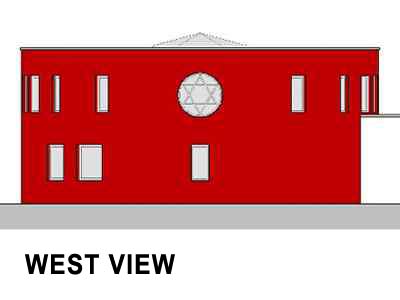| 03-20-2010 |
As Sure as “Amen” in the Synagogue
Dewezet, March 20, 2010
by Wolfhard Truchseß
HAMELIN — Rachel Dohme is very happy. The president of the liberal Jewish Congregation of Hamelin is thrilled that the long cherished dream will finally become a reality. “First it was an idea,” said Rachel Dohme, “then a dream and now a reality.” The dream was the rebuilding of the Hamelin synagogue.

After years of planning, the city of Hamelin has issued a building permit which will see the Jewish community center and synagogue erected on the same spot where the Hamelin synagogue stood until its destruction in 1938. The building project will commence this year. American and British Jewish congregations have shown marked interest as well as many Christian churches. Hamelin Jews as well as Christians make up the project’s building committee, which meets regularly and works hand in hand with the architects.
This will be the first newly constructed Reform synagogue in Germany. “Other German Reform congregations have opened synagogues but they have been renovated and rededicated existing buildings. This will be the first new construction and it will be built on the original parcel of land where the Hamelin synagogue stood when it was dedicated in 1879.” said Dohme. The dedication is slated for February 2011 with Lower Saxony’s Minister President Christian Wulff invited to attend and speak.
“It has been a long road,” recalls Rachel Dohme, remembering the project’s many hurdles and obstacles. The idea to rebuild a synagogue on the very soil where it had stood until it’s destruction by fire at the hands of the Nazis on November 9, 1938, originated from former Hamelin mayor, Mr. Klaus Arnecke. Dohme, president and lay leader of the 200-member congregation remembers: “I had an appointment with Mayor Arnecke and was accompanied by Mrs. Christa Bruns, president of the Society of Christians and Jews. I was hoping the city could offer us an inexpensive rental space for our congregation to meet. Mayor Arnecke asked, ‘Why not build a synagogue on the old spot in the Bürenstrasse?’”
Originally, Mayor Arnecke offered the congregation the land for a symbolic 1 Deutsch Mark. The city treasurer saw things differently and demanded “a fair price.” In the end the congregation was forced to agree to pay a sum of 40,000 DM. (ca. $20,000).
In a macabre twist, the Jewish Congregation of Hamelin was forced to sell the land to the city of Hamelin in March 1939 for 7500 Reichsmark. The city retained 1500 Reichsmark for cleaning up the demolition of the destroyed synagogue. The remaining 6000 Reichsmark were not paid to the congregation but to the “National Organization of Jews in Germany,” whose assignment it was to collect Jewish assets and property and transfer the accumulated wealth to the Nazi government.
The first design for the new synagogue came from American architect Arnold Oppler, the great grandson of Edwin Oppler, the German-Jewish architect who built the original synagogue in 1879. “Arnold Oppler’s plans were beautiful but impossible for our congregation to realize with a price tag of over 3.5 million Euros, ” regretted Dohme. The collaboration had to come to an end. “Mr. Oppler understood that we would not be able to build his building.”
The new design was created by Architect Frank Taylor. It envisions an oval form with a sanctuary with seating for one hundred and classrooms, offices, and a library.
The project is under the auspices of a foundation created solely for the purpose of overseeing and administrating the construction, Foundation Liberal Synagogue Hamelin.
The architect firm Naserek is under contract to manage the construction. Groundbreaking is planned for this spring.
The building costs of one million Euros is being shared by the city of Hamelin, the county of Hamelin-Pyrmont, the state of Lower Saxony, and the Foundation. Foundation president Dohme notes that the Foundation has raised half the necessary funds through “contributions large and small” and hopes for “additional donations and gifts in kind.” A bank loan will be necessary. The Wilkhahn chair factory has pledged seating, and Vorwerk carpet factory has offered carpeting, and the Junker Roof Company will provide the entry way roof.
“The new building is a Reform synagogue and, in contrast to an Orthodox congregation, men and women are equal in all religious rights and responsibilities. Our congregation is lead by a female rabbi, Rabbi Irit Shillor. We pray in Hebrew, German, and Russian. Our services are musical events; the congregants sing, accompanied by piano and other musical instruments. We envision our building to be multifunctional, and will be available for both religious and secular programs. Religious services, lectures, and concerts will create a welcoming atmosphere for Jews as well as our non-Jewish neighbors and friends.” said Dohme. “We are certain the building will be built, and that’s as sure as the ‘Amen’ in the Synagogue!”